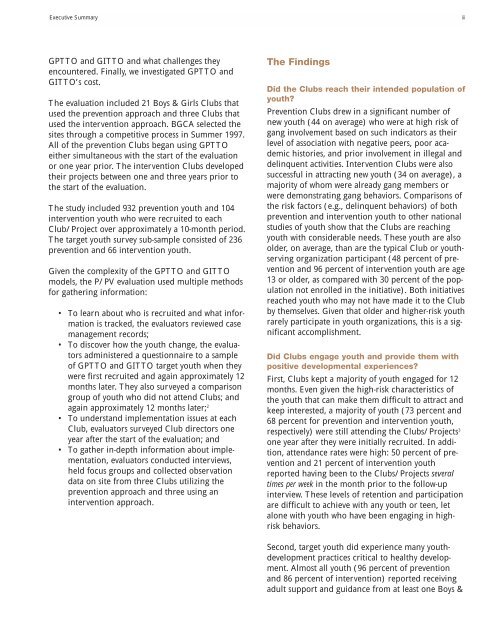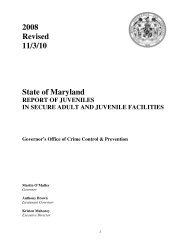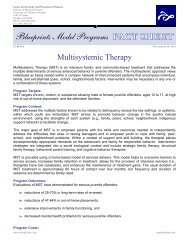Targeted Outreach - Governor's Office of Crime Control & Prevention ...
Targeted Outreach - Governor's Office of Crime Control & Prevention ...
Targeted Outreach - Governor's Office of Crime Control & Prevention ...
Create successful ePaper yourself
Turn your PDF publications into a flip-book with our unique Google optimized e-Paper software.
Executive Summary<br />
iii<br />
GPTTO and GITTO and what challenges they<br />
encountered. Finally, we investigated GPTTO and<br />
GITTO’s cost.<br />
The evaluation included 21 Boys & Girls Clubs that<br />
used the prevention approach and three Clubs that<br />
used the intervention approach. BGCA selected the<br />
sites through a competitive process in Summer 1997.<br />
All <strong>of</strong> the prevention Clubs began using GPTTO<br />
either simultaneous with the start <strong>of</strong> the evaluation<br />
or one year prior. The intervention Clubs developed<br />
their projects between one and three years prior to<br />
the start <strong>of</strong> the evaluation.<br />
The study included 932 prevention youth and 104<br />
intervention youth who were recruited to each<br />
Club/Project over approximately a 10-month period.<br />
The target youth survey sub-sample consisted <strong>of</strong> 236<br />
prevention and 66 intervention youth.<br />
Given the complexity <strong>of</strong> the GPTTO and GITTO<br />
models, the P/PV evaluation used multiple methods<br />
for gathering information:<br />
• To learn about who is recruited and what information<br />
is tracked, the evaluators reviewed case<br />
management records;<br />
• To discover how the youth change, the evaluators<br />
administered a questionnaire to a sample<br />
<strong>of</strong> GPTTO and GITTO target youth when they<br />
were first recruited and again approximately 12<br />
months later. They also surveyed a comparison<br />
group <strong>of</strong> youth who did not attend Clubs; and<br />
again approximately 12 months later; 2<br />
• To understand implementation issues at each<br />
Club, evaluators surveyed Club directors one<br />
year after the start <strong>of</strong> the evaluation; and<br />
• To gather in-depth information about implementation,<br />
evaluators conducted interviews,<br />
held focus groups and collected observation<br />
data on site from three Clubs utilizing the<br />
prevention approach and three using an<br />
intervention approach.<br />
The Findings<br />
Did the Clubs reach their intended population <strong>of</strong><br />
youth?<br />
<strong>Prevention</strong> Clubs drew in a significant number <strong>of</strong><br />
new youth (44 on average) who were at high risk <strong>of</strong><br />
gang involvement based on such indicators as their<br />
level <strong>of</strong> association with negative peers, poor academic<br />
histories, and prior involvement in illegal and<br />
delinquent activities. Intervention Clubs were also<br />
successful in attracting new youth (34 on average), a<br />
majority <strong>of</strong> whom were already gang members or<br />
were demonstrating gang behaviors. Comparisons <strong>of</strong><br />
the risk factors (e.g., delinquent behaviors) <strong>of</strong> both<br />
prevention and intervention youth to other national<br />
studies <strong>of</strong> youth show that the Clubs are reaching<br />
youth with considerable needs. These youth are also<br />
older, on average, than are the typical Club or youthserving<br />
organization participant (48 percent <strong>of</strong> prevention<br />
and 96 percent <strong>of</strong> intervention youth are age<br />
13 or older, as compared with 30 percent <strong>of</strong> the population<br />
not enrolled in the initiative). Both initiatives<br />
reached youth who may not have made it to the Club<br />
by themselves. Given that older and higher-risk youth<br />
rarely participate in youth organizations, this is a significant<br />
accomplishment.<br />
Did Clubs engage youth and provide them with<br />
positive developmental experiences?<br />
First, Clubs kept a majority <strong>of</strong> youth engaged for 12<br />
months. Even given the high-risk characteristics <strong>of</strong><br />
the youth that can make them difficult to attract and<br />
keep interested, a majority <strong>of</strong> youth (73 percent and<br />
68 percent for prevention and intervention youth,<br />
respectively) were still attending the Clubs/Projects 3<br />
one year after they were initially recruited. In addition,<br />
attendance rates were high: 50 percent <strong>of</strong> prevention<br />
and 21 percent <strong>of</strong> intervention youth<br />
reported having been to the Clubs/Projects several<br />
times per week in the month prior to the follow-up<br />
interview. These levels <strong>of</strong> retention and participation<br />
are difficult to achieve with any youth or teen, let<br />
alone with youth who have been engaging in highrisk<br />
behaviors.<br />
Second, target youth did experience many youthdevelopment<br />
practices critical to healthy development.<br />
Almost all youth (96 percent <strong>of</strong> prevention<br />
and 86 percent <strong>of</strong> intervention) reported receiving<br />
adult support and guidance from at least one Boys &

















